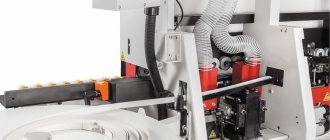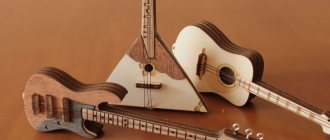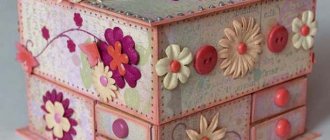The carpentry business will never lose its relevance. Wooden products always remain in fashion. If you approach the matter wisely, you can count on stable profits. A business plan will help organize the process of starting a project from scratch. We’ll look at what a step-by-step guide for a novice entrepreneur includes in this article.
| Starting investment, rub | Revenue per month, rub | Net profit, rub | Payback period |
| from 300,000 | from 300,000 | from 80 000 | 6 - 12 months |
Carpentry as a business - pros and cons
For those who are just trying themselves as the owner of a carpentry company, it is useful to know in advance what advantages and disadvantages the workshop offers.
Pros of the project:
- you can start a business in your garage and not spend money on rent;
- wooden products are always in price and in demand;
- To start a business, you need a minimum of tools. New equipment is purchased gradually - as the business develops;
- a wide range of products - from standard products to unique orders. This helps overcome competition.
Flaws:
- carpentry workshop is passive income;
- without hired workers, it will not be possible to achieve mass production and stable profits;
- The threshold of competition in this area is one of the highest - in order not to go bankrupt, you need to find your advantage. It is difficult to resist large furniture companies;
- the client base is formed slowly, and advertising is expensive;
- work is associated with the danger of occupational injuries;
- the raw material is expensive, which increases the cost of the product. In such conditions it is difficult to maintain a flexible pricing policy.
Types of joinery
The first thing you should start with is to choose the category of goods that you will produce. There are a huge number of different wood products on the market, but you should first of all be interested in positions that produce mini carpentry, which employs one or two craftsmen; it is these companies that will be your main competitors.
In fact, there are two main approaches to building a product line:
- Wide specialization. This approach means that you will make a large number of products and sell them either wholesale or retail. There is less emphasis on quality and more emphasis on the volume of items sold.
- Narrow specialization. In this case, you choose a narrowly focused product, for example stairs, and become a pro in this area. In this case, you can value your work above the market and receive the same profit as the masters who, for example, sold tens or hundreds of souvenirs.
The choice of specialization should be made based on the possibilities of selling your products.
If we talk about the most popular product items in the carpentry business, then we can distinguish several main categories.
- doors and windows.
- stairs.
- furniture (cabinets, tables, chairs, chests of drawers).
- wooden fences and decorative gazebos.
- souvenirs, gifts and other small goods.
- kitchen accessories (cutting boards, spatulas, rolling pins, etc.).
- board games and wooden toys.
- accessories for home interior (flower pots, key holders, shelves, stands, armchairs, coffee tables, picture frames, etc.).
- packaging products (boxes, containers).
It is worth knowing that all these categories of goods are represented in large retail chains, and it will be difficult for you to compete with them, especially regarding the issue of price. Thus, plastic windows have long become much more popular than wooden ones, and furniture from Ikea is more affordable and looks good for the money. In addition, many plastic products are literally several times cheaper than similar wooden solutions, which also affects the choice of buyers.
What kind of wood do carpentry workshops most often work with?
The next issue that you have to deal with before opening a carpentry workshop is the choice of wood with which you will work. The market for these services has already formed a certain “TOP” of wood species that are most often used in carpentry.
- Pine.
- Oak.
- Birch.
- Beech.
- Ash.
Less popular are products made from larch, teak and mahogany. Pine is the most popular material, this is justified, firstly, by the low price and, secondly, by the good characteristics of the wood itself. But there are also difficulties when working with this material, for example, the fact that it is very difficult to paint, especially in light colors. In addition, it is often difficult to find well-dried pine material, since it is sold out first. Oak products are already much more expensive, but their quality is much higher. For example, when making the same beds, the client is offered a set of prices for beds made of different types of wood, and these figures can differ twice, even with the same appearance of the bed itself.
What product colors do customers choose?
The second parameter that affects the price and range of products is the choice of color of the product. So, for example, painting white costs much more than a darker color, for example wenge.
Here is a list of commonly used color schemes for wood products.
- White
- Wenge
- Nut
- Grey
- Brown
- Cherry
- Lactic
- Alder
- Oak
- Ash
- Black
- And others
Each manufacturer has its own list of colors, but at the same time, many carpentry workshops offer color selection and painting of wooden structures in the desired tone.
Suppliers and work format
You should look for wood suppliers at wholesale stores with ready-made (processed) material, or contact the nearest sawmills, where they can produce wood blanks specifically for your requirements.
The second point is the fittings, this applies if you work with furniture or make interior items. In this case, you can choose either cheap Chinese designs or decor, or work with high-quality German or Italian components.
If we talk about the business format chosen in this article, namely the work of a master “alone,” then perhaps it makes sense to look towards quality rather than quantity. The price of the product is calculated by summing up the costs of materials (wood, paint, varnish, etc.) and multiplying it by a coefficient that will form your earnings. The value of the coefficient depends on how expensive the craftsman positions himself, but a markup of 100% usually does not justify the labor and time spent on making handmade products.
Selecting a room
At the initial stage of organizing their business in this niche, many craftsmen do not have the financial ability to rent space for their own workshop, and therefore they organize a carpentry business in a garage or utility room near a private house. Working from home allows you to save money, and at the same time, with a little preparatory work, you can prepare your workshop for launch.
Here is the usual set of requirements that apply to the premises for such a workshop.
- Room area – 35 – 60 sq.m. The area will depend on the dimensions of the products you will make. Usually, in addition to the working area, they organize a small warehouse for materials and a workplace for the master.
- They try to maintain the humidity level in the room at up to 35%.
- Temperature: +18 – +20 degrees Celsius.
- The length of the walls of the same garage is from 4 m. This is necessary to accommodate wood processing machines.
- Lighting - natural and artificial.
- Electricity, sockets are preferably 380 V, but 220 V is also possible.
- Good ventilation of the workshop interior.
- Fireproof treatment of walls and ceilings, or finishing with non-combustible materials.
- If your garage is located right next to your house, then it would be a good idea to soundproof the work area.
All tools are placed on racks and shelves along the walls. Working machines are placed in the center so that they can be accessed from different sides. The area required for the machine is calculated according to its dimensions, multiplied by 1.5 - 2.
Set of equipment for carpentry shop
The issue of choosing equipment for a carpentry shop is one of the main steps in this business. In fact, the bulk of the starting capital will go towards the purchase of instruments. It is difficult to outline a clear list of all the equipment, because depending on the specialization, your skills as a master and other factors, the set of devices will be different. We will try to indicate the base from which you can start your business in this niche.
So, what does it take to open a carpentry workshop?
Hand tool:
- Wood saws.
- Mallet.
- Planer and planer.
- Screwdrivers of various types.
- Pliers.
- Stationery knives.
- Adjustable wrench.
- Wood chisel.
- Furniture stapler.
- Awl and nippers.
- Vise.
- Clamps.
- Roulette.
- Metal ruler and measuring square.
- Level.
- Power tools: screwdriver, drill, jigsaw, sander (belt).
This is the basic kit for making simple wood products. Here you can also add consumables such as drills, sandpaper, screwdriver bits, pencils and other things. The cost of such a set of tools for a beginner can be $550 – $650.
If your task is to produce more complex wooden structures, such as furniture, doors or interior items, then you will need more serious financial investments in the purchase of expensive equipment. In this case, the amount for equipment can increase to $4000 – $4900.
Here is a list of the main power tools that woodworkers use in their work.
- Lathe – from $500
- Circular or miter saw - from $400
- Reismus - from $1450
- Milling cutter (manual) – from $80
- Electric planer – from $65
- Air compressor – from $250
- Spray gun for applying paint and varnish – from $70
- Circular saw – from $145
- Jointer - from $400
- Moisture meter - from $30
Let's add here the amounts for the power tools indicated above:
- Screwdriver - from $65
- Drill – from $80
- Jigsaw – from $65
- Grinding machine – from $225
And we’ll also include the amount for hand tools: about $225
The total amount for the purchase of equipment for organizing a mini carpentry business will be from $4050. This amount does not yet include a work table for the master, racks and shelves for storing tools, and work clothes. These calculations will vary depending on the manufacturing companies for the equipment, because the price can vary significantly.
There are some tips that can be given to beginners that they need to consider before starting a carpentry business completely from scratch.
- Do not buy expensive devices that you will rarely use, or which can be replaced with cheaper analogues. As an example, this is an expensive plunge-cut saw and in comparison it is an ordinary circular table. Some tasks can be delegated to sawmills, especially at the beginning.
- When starting your business, don’t try to immediately buy power tools from the most expensive brands. Yes, it is high-quality and reliable, but you can start with cheaper analogues that will serve you for several years while you gain experience and in the future you can afford a more expensive tool.
- Set aside money from each order for repairs and the purchase of new equipment.
- Buy only what you really need. To do this, you can arrange the entire set of tools according to priority tasks.
- Be sure to follow safety precautions when working with electrical appliances.
Even at the stage of planning your carpentry shop, you need to make a list of tools, find out prices and calculate the amount needed to purchase them.
Staff
The situation with personnel in this field of activity is very interesting, since most of the craftsmen who are trying to build a small business in this niche work independently, and it is very difficult to find an experienced carpenter who will carry out your orders.
Typically, in such a “single” business, only assistants are hired who do the rough work of sanding and preparing the wood for subsequent processing. Thus, carpenters speed up the development of products, and at the same time do not create competitors for themselves. After all, it is a common practice that students, as soon as they gain skills, leave and open their own business.
Where to look for clients?
The issue of searching for markets for wooden products is very acute, and in modern realities, only those carpentry shops that invest money in advertising their products and expanding their customer base make money. There is no point in talking about the fading demand for wood products, given the increased construction activity of the private sector in recent years; the main thing here is to find and reach the client correctly. And since most of these workshops are located on the outskirts of the city, or in the format of a carpentry shop in a garage, external advertising works poorly here.
- Direct sales of your own products to furniture, gift and other retail stores, depending on your specialization.
- Creating your own online store with a catalog, examples of work and prices.
- Promotion of pages on social networks. Instagram and Facebook work great. There you can publish photos of your work, customer reviews and workflow, while simultaneously purchasing paid advertising in these networks.
- Advertising on bulletin boards (Avito, OLX), with the purchase of placement in the TOP.
- Participation in exhibitions and fairs in your specialty.
- Posting advertisements in your region.
Word of mouth also works well in this business, especially if you sell a quality product at an adequate price, meeting the deadlines for order production.
How much money do you need to start?
When developing a business plan for a carpentry workshop, it is important to carry out all the calculations and calculate all cost items for starting and maintaining a business. In addition to the amount of starting capital, you will receive a guideline for calculating the return on your investment. In each individual case, the amount will be different, but as an example, we will indicate the main expense items.
Starting investments:
- Purchase of equipment – $4000 – $5000
- Indoor renovation and customization of workshop requirements – from $1500
- Paperwork – $200
- Starting purchase of materials – from $500
- Advertising products (website, logo, business cards and leaflets) – from $450.
Monthly payments:
- Taxes – $250
- The assistant's salary is negotiable, based on the work performed.
- Replenishment of materials - depending on the volume of orders.
- Advertising – from $150
- Transportation costs – from $80
- Payment of utilities – from $100.
We did not include rent in the expense items, since this means working in your own garage, but if you don’t have one, then you need to add this expense item to your monthly payments. If you want to save money, you can buy some of the equipment used, or you can pay craftsmen who will make workbenches at an affordable price with the same functionality.
How much can you earn?
The profitability of a carpentry workshop is 7% – 15%. Everything will depend on the effectiveness of advertising, the personality of your products and the competition in the niche in which you plan to work.
The return on investment in this business occurs over a period of 1 – 1.5 years.
Conclusions. Carpentry as a business is a good start for a craftsman who wants and loves to work with wood and create his own unique products. This is a competitive niche where you need to competently plan sales markets and only after that invest in the purchase of expensive equipment and personnel search.
How much money do you need to start a carpentry business?
To assess the economic efficiency of a project, you need to understand what the investments will be.
To start a workshop from scratch, you will need half a million rubles. The main expense item is equipment.
An example of a cost estimate for opening a carpentry shop:
- rental of premises - 25,000 rubles;
- equipment and tools - 250,000;
- raw materials for the first month of work - 50,000;
- utility bills - 5,000;
- wage fund - 120,000;
- advertising at the start - 50,000;
- current promotion costs - 10,000 per month.
Profitability of a carpentry workshop
Carpentry can hardly be called a highly profitable business. This indicator is tied to the following factors:
- advertising effectiveness;
- individuality of products;
- threshold of competition in the region.
If we talk about average figures, the profitability level in the carpentry business is 10-15%.
Necessary equipment for opening a carpentry workshop
What tools and equipment are required depends on the format of the business.
Basic set of hand tools:
- answers;
- mallets;
- chisels;
- saws;
- vice;
- clamps.
Power tools:
- jigsaw;
- grinding apparatus;
- screwdriver;
- drill.
To manufacture complex and large products you need:
- lathe and grinder;
- spray gun;
- compressor;
- circular;
- surface planer
You can reduce costs by purchasing new equipment.
How to select personnel
The selection of staff is approached responsibly. A company's reputation has a direct connection with the quality of their work. Hire candidates who have specialized education and work experience in their specialty.
In order for the workshop to function fully and without interruptions, you will need:
- production technologist - will control the process and participate in its organization;
- carpenter - 2 people;
- assistant carpenter - 2 people. They will take over small operations and assemble finished products. Their labor is valued cheaper than the services of a carpenter;
- general workers - 2-3 people. Their responsibilities: pack the goods, clean the hall, perform loading and unloading;
- Sales Manager;
- accountant - alternative - an outsourcing agreement with a company.
For staffing, the cost estimate includes 120,000 - 140,000 rubles every month.
Note ! At the stage of project promotion, you can take on part of the operations yourself or work in one shift. This will reduce payroll costs. As orders appear, additional personnel are recruited.
Where to get finance
My financial situation was very deplorable at that time. And the idea of doing carpentry scared me more than it excited me. There was only $80 in the family budget, and investing all this money would be a big risk. Moreover, with a child - a preschooler.
I had to look for a way out of the situation and ask to borrow money from my older brother. He lent me $300 for six months, with the expectation that I would return the money by the New Year. Therefore, we had to work long, hard and diligently.
Why didn't I take out a loan? It's simple. I already had a loan for a refrigerator, and no one would give me a new one. In addition, while paying off this loan, I realized that it is better not to mess with banks and their crazy interest rates.
What products and services will the carpentry shop produce?
A small carpentry company can produce:
- home interior items - stairs, doors, windows, frames, finishing panels;
- decorative elements - wooden partitions, screens, columns;
- building materials - parquet, timber;
- country interior - benches, gazebos;
- furniture;
- small accessories - souvenirs, toys, bath products.
Depending on the material, these will be budget products or exclusive products. For small production, it is better to work with individual orders. Author's solutions cost 3-4 times more than serial models. The main thing is to have a high-class master.
Wood selection
If you've been in hardware stores or lumberyards a lot lately, you know that you often find low-quality wood there. Which is hardly suitable for a good product. Craftsmen learn to select the appropriate material and avoid warped, bulging, twisted, twisted or split boards. Read more about choosing wood in our article.
Production plan
To set up a workshop for the production of wood products, you must rent a premises with an area of at least 150 square meters.
Carpentry workshop layout:
- production workshop - 75-80 square meters;
- warehouse No. 1 - wood storage;
- warehouse No. 2 - finished products;
- staff room;
- bathroom, shower.
Premises requirements:
- water pipes;
- heating system;
- electricity;
- sewerage;
- ventilation system.
The room must be dry - wood easily absorbs moisture. The properties of the material deteriorate. Temperature range: 18-22 degrees.
Workshop lighting plays an important role. Windows should occupy at least a quarter of the entire area. If you plan to release doors or windows, consider the height of the ceilings. Minimum - 4 meters.
Advice! Choose a location away from residential premises and the center - this way you will save on rent and not violate sanitary standards.
Where it all started
Good afternoon. My name is Vasily Zorin and I am 49 years old. Nine years ago I started doing carpentry - making wooden shelves, racks, and racks to order. I live in the small town of Belgorod, where my first business was launched. A painter and plasterer by training, a paramilitary cash collector by trade, a carpenter at heart. My small business didn’t last very long, but more on that later.
From father to son
My wife and I have been living in her parents’ house for 15 years. My father-in-law was a jack of all trades: he built the house himself, made all the furniture himself, and carved children’s furniture and toys for his grandchildren. He had a separate large workshop where he planed all wooden objects. After he passed away, all this wealth was left to my wife and me.
To say that I was a frequent guest there is no. Although I knew all those tools and how to work with them, I used them very rarely. And then fix something around the house, file it, knock it out, etc. Moreover, I didn’t have time to plan anything - I worked as a paramilitary cash collector within two days, and made good money.
Reduction of staff and job searches
Everything changed when staff reductions began at my work due to the crisis. Many quit, many were fired, transferred to another mode of work. It’s the same with me - they offered to work 2 through 2, or 3 through 3, but they didn’t imagine a hostel. But looking in another city and renting housing is very expensive.
How to advertise a carpentry workshop
A competent advertising company will help you express yourself and find new clients. Effective ways to promote a product or service:
- submit a free ad on the regional administration website;
- Post advertisements at wholesale warehouses of building materials;
- install an advertising stand near a supermarket or shopping center;
- create your own website on the Internet - fill the page with a product catalog, price list, and useful articles on the topic. Provide the opportunity to place an order directly from the site;
- distributing leaflets and business cards - this method of promoting a service cannot be called effective. It is not advisable to use it as the main method of advertising, but it is quite possible as an additional method. The advantage of this method is its low cost compared to other marketing methods.
When hands grow from the right place
Even at the thinking stage, my business had already begun to function. When I turned to my friends with a request to “promote” me at the market, I received my first order. Therefore, I was already looking for money directly for the material.
First order
My friends ordered me new lying shelves for their containers. I had to make 4 shelves 1.2*2.3 meters, 2 shelves 1.4*2.2 meters and two 1.0*2.5 meters. While I was waiting for the material from the base - they deliver it themselves, I developed sketches of future products and calculated how much timber, material and varnish I needed.
Varnish is the only item that I did not take into account in my plans. And you must use it - it gives the product a beautiful look and protects the timber from harmful influences. A 4-liter bottle of polish cost me $7.
I spent almost two weeks making my first order. I almost ruined 3 meters of timber due to the fact that I incorrectly removed the markings and marked the drilling points. But, at exactly the agreed time, I took the finished racks to a friend and earned $320.
Things got better little by little
After we placed the finished racks in containers at the market, neighboring retailers bombarded me with orders.
In one month, I made 18 racks, including a friend’s order, and then received a large order for 28 racks for the owner of seven containers with clothes and shoes at our market. Therefore, the whole month has already been filled with this order. In the third month of my work, I took only 3 orders for 6 floor shelves, 2 wall shelves and a folding shelf.
Shoe racks.
Carpentry is a job that can be done regardless of the time of year or weather, especially if your workshop has a roof. After several months of my work, I received an order for the fall - to equip a new perfume and cosmetics store with shelving. It took me 2 weeks to make everything, after which orders began to arrive less and less often. Before the New Year, I accepted only 4 orders and made only 12 shelves and 4 racks.
Paperwork
To register a company, you should contact the tax service at the location of the legal address of the object.
Package of documents for registration of individual entrepreneur:
- passport - original and a copy of all pages;
- TIN - if available;
- written application of the established form P21001;
- check for transfer of duty - 800 rubles;
- tax form statement.
Documents for LLC:
- application for registration, sample P11001;
- passports of those who will become founders, plus copies of all pages;
- fee payment receipt;
- minutes of the founders' meeting. If the founder is one person - his decision to form an LLC;
- articles of association;
- application for the tax form chosen by the founder.










